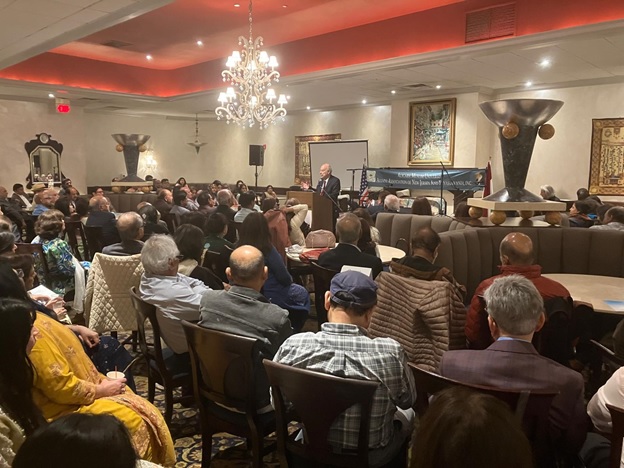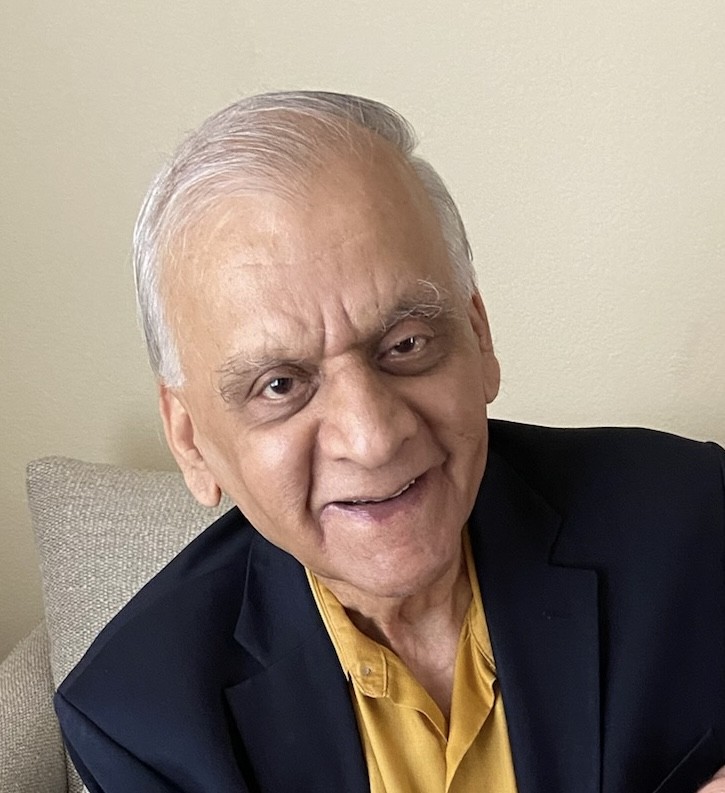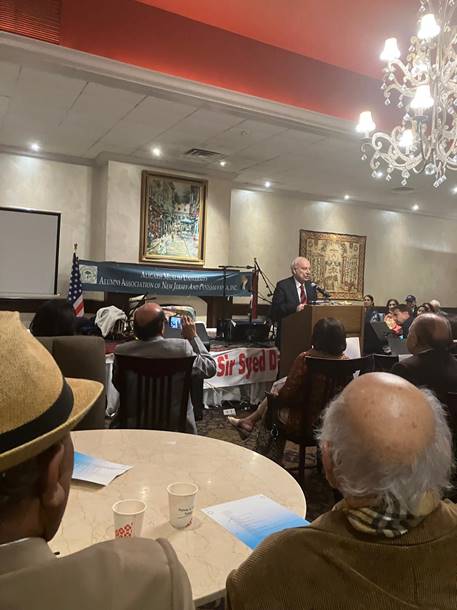

The keynote address was delivered by Distinguished Professor Akbar Ahmed of American University of Washington DC. Professor Ahmed is the author of several award-winning books and films including Jinnah starring Christopher Lee
Remembering Sir Syed Ahmad Khan
By Dr Masood Haider

On the 24 th of October, the Aligarh Muslim University Alumni Association of New Jersey and Pennsylvania organized an event to celebrate the birth anniversary of Sir Syed Ahmad Khan. The association has been faithfully honoring Sir Syed over the years but has suspended their activities due to COVID and this was the first time that they had re-convened. It was a packed program with a guest speaker and Qawwali by the famous Qawwali singer, Imran Aziz Mian, son of the legendary late Aziz Mian. As an Aligarh alum the event was close to my heart.
The keynote address was delivered by Distinguished Professor Akbar Ahmed of American University of Washington DC. Professor Ahmed is the author of several award-winning books and films including Jinnah starring Christopher Lee. He was Pakistan’s High Commissioner to the UK and Ireland and is featured in the Muslim 500 in the top 50 ‘honorable mentions.’ Professor Ahmed came down from Washington DC for the event. His topic was “The Challenges of Being Muslim in the 21 st Century – Lessons from Sir Syed.”
Ahmed began his speech by introducing Sir Syed Ahmad Khan and the highlights from his life. Ahmed stated that boldly for that time, Sir Sayyed blamed the British for the uprisings of 1857–58, but his criticism was couched in the language of friendship. He pleaded with the British to take steps to end the sense of isolation and grievance among Muslims. He recommended, for example, that Muslims should be appointed to high office. He pleaded with Muslims not to harbor contempt and hatred for the British and their deeds but to concentrate on what was common between them and what they could learn from these foreign colonizers so that they could survive with dignity.
Aligarh created a community that not only led the Muslims in India but that could also confidently step into the world within a few decades of the traumatic events of 1857–58. By giving the Muslim community, a sense of both confidence and direction, Aligarh demonstrated that Islam was indeed relevant and could contribute to the modern world. In contrast, the mystics and the orthodox of Islam were both finding it difficult to adjust to modern times. By the mid-twentieth century, as the Muslim lands emerged to form independent states, it looked as though the Aligarh model would prevail.

Ahmed was particularly concerned with the young generation, including those living in the West. They face widespread Islamophobia and the mocking of their religion and culture. Hecited the recent University of Maryland poll which identified the Muslim community as the most unpopular in the United States. Here again, Sir Syed’s lessons are relevant to today’s youth: How to convert enemies into friends
Ahmed introduced the concept of inflection points of Muslim history when the trajectory of history changes and so does Muslim destiny. One of the early examples is the defeat of the Roman empire by the brilliant military genius Khalid bin Waleed. Another inflection point comes with the total destruction of Baghdad and its population by Halaku Khan and his Mongol armies. The Mongols destroyed everything, even the irrigation canals. The rivers had turned black because of the ink from the books that the Mongols had taken from the libraries and thrown into the rivers. Yet it was Berke Khan, a relative of Halaku, who brought his Mongol troops from Russia to support the Muslims and prevent further bloodshed as he had become a Muslim. Within a generation or two the Mongols began to convert to Islam and many of the great dynasties of Asia would be descended from these very Mongols. Indeed, the great Babar, the founder of the Mughal empire proudly claimed descent from the Mongols. Another inflection point that created problems for the Muslims was the battle of Plassey and the defeat of the Nawab of Bengal, the slow but sure encroachment of the British on the Mogul empire, and in time, the loss of the empire and the crisis of 1857. After 1857 the Muslims lost an empire, their emperor, their language, and political power. The British blamed the Muslims for the uprisings and a hundred thousand young men at least were hung on trees along the main highway to Delhi. It was the lowest point for the Muslims of South Asia. If nothing had changed the future of Muslims appeared doomed. It was at this low point when Sir Syed emerged and created his college at Aligarh which soon became a university that was to play such a significant role on the entire subcontinent giving presidents and prime ministers from its ranks.
So, we have a paradigm from history when Muslims confront a disastrous situation but are able to convert it into one of victory and even triumph. What were the lessons that we can learn from this paradigm for our times? The first lesson is to emphasize the importance of education. This is perhaps the single most important lesson from Sir Syed. An education not only of poetry and literature but of science and engineering. The next lesson is to meet the situation with resolution and resilience, not to be faint-hearted. Another lesson is to tackle the new paradigm with humility and self-confidence. There is also the need to reach out and build bridges with non-Muslims so that the community has friends and allies. Sir Syed aimed to convert the British who had been most aggrieved into supporters and friends. This, he succeeded in doing and changed the course of history. Sir Syed created a Muslim renaissance. His movement created the condition for Alama Iqbal and Quaid-i-Azam and the Pakistan movement which lead to the creation of the largest Muslim nation in the world in 1947. That Pakistan did not live up to the aspirations and ideals of the Quaid-i-Azan is a constant reminder to every Pakistani that their nation is a work in progress.
Ahmed was particularly concerned with the young generation, including those living in the West. They face widespread Islamophobia and the mocking of their religion and culture. He cited the recent University of Maryland poll which identified the Muslim community as the most unpopular in the United States. Here again, Sir Syed’s lessons are relevant to today’s youth: How to convert enemies into friends.
We too face a similar situation with Islamophobia globally reminding us of the plight of Muslim communities across the world including in the Middle East, and South Asia, and then Far East Asia. The younger generation desperately needs some sense of a roadmap, some guidance, and confidence. In interesting ways, therefore, we are able to extract lessons from Sir Syed’s life. So, we have a 19 th-century figure providing a role model for us in the 21 st century.
The event was organized at the well-known Zara’s restaurant which was packed by some 200 guests. It was a great success and assisting me was my marvelous wife Sanobar along with the worthy Dr Zaid Hassan and his wife Rubina. Many notable people from the area and beyond attended the dinner and event which they enthusiastically appreciated with members of the audience expressing their delight. My note to Professor Ahmed summed up the feelings of the audience: “Your keynote address as usual was spellbinding and absolutely mesmerized the audience.”
(Dr Haider was a student during Aligarh’s golden age and received his PhD in Biochemistry from the University of California. He was one of the founding members of the Aligarh Alumni Association of New York Tri-State established a quarter century ago with which he remained associated for thirteen years after which he established the Aligarh Alumni Association of New Jersey and Pennsylvania, Inc.)

